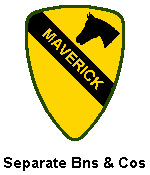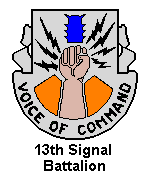

13th Signal Battalion
Campaign Streamers
"Voice of Command"

![]()



![]()
|
|---|
![]() The concept of campaign streamers came to prominence in the Civil War when
Army organizations embroidered the names of battles on their organizational
colors. This was discontinued in 1890, when units were authorized to place
silver bands, engraved with the names of battles, around the staffs of their
organizational colors. When American Expedition Forces Units in World War I
were unable to obtain silver bands, General Pershing authorized the use of
small ribbons bearing the names of the World War I operations. In 1921 all
color-bearing Army organizations were authorized to use the large campaign
streamers currently displayed.
The concept of campaign streamers came to prominence in the Civil War when
Army organizations embroidered the names of battles on their organizational
colors. This was discontinued in 1890, when units were authorized to place
silver bands, engraved with the names of battles, around the staffs of their
organizational colors. When American Expedition Forces Units in World War I
were unable to obtain silver bands, General Pershing authorized the use of
small ribbons bearing the names of the World War I operations. In 1921 all
color-bearing Army organizations were authorized to use the large campaign
streamers currently displayed.
![]() Only campaign streamers (2 3/4 inches wide and 4 feet long), embroidered with
the designation of a campaign and the year(s) in which it occurred, are
displayed on the Army flag. The 174 streamers attached to the Army Flag staff
denote campaigns fought by the Army throughout our nation's history. The
identification colors of the streamer is identical to the color design of the
campaign ribbon authorized for service in that particular theater of war.
Only campaign streamers (2 3/4 inches wide and 4 feet long), embroidered with
the designation of a campaign and the year(s) in which it occurred, are
displayed on the Army flag. The 174 streamers attached to the Army Flag staff
denote campaigns fought by the Army throughout our nation's history. The
identification colors of the streamer is identical to the color design of the
campaign ribbon authorized for service in that particular theater of war.

![]()
![]() Streamers (2 3/4 inches wide and 3 feet in length) are currently authorized
for display by organizations authorized a distinguishing flag to indicate the
following:
Streamers (2 3/4 inches wide and 3 feet in length) are currently authorized
for display by organizations authorized a distinguishing flag to indicate the
following:
![]() Streamers are affixed to the attaching device in a counterclockwise manner.
LEXINGTON 1775 is the first streamer and KOSOVO AIR CAMPAIGN will be the 174th
streamer (with an additional streamer to be added at a later date). When the
United States flag is not being carried, the streamers will be arranged in
such a manner that LEXINGTON 1775 is displayed in the preeminent position,
i.e., in the center facing forward and completely identifiable. The streamer
awarded for the most recent campaign will also be visible.
Streamers are affixed to the attaching device in a counterclockwise manner.
LEXINGTON 1775 is the first streamer and KOSOVO AIR CAMPAIGN will be the 174th
streamer (with an additional streamer to be added at a later date). When the
United States flag is not being carried, the streamers will be arranged in
such a manner that LEXINGTON 1775 is displayed in the preeminent position,
i.e., in the center facing forward and completely identifiable. The streamer
awarded for the most recent campaign will also be visible.
![]() Separate Table of Organization and Equipment (TOE) units authorized a guidon
will indicate campaign participation credit by use of a silver band in lieu of
a campaign streamer. The silver band is placed on the guidon staff immediately
below the guidon. Campaign participation credit for companies of battalions
are reflected by the battalion streamer since honors for those companies
accrue to the battalion if the battalion received credit. If the battalion did
not receive credit but individual companies received credit, the silver band
may be displayed by the company.
Separate Table of Organization and Equipment (TOE) units authorized a guidon
will indicate campaign participation credit by use of a silver band in lieu of
a campaign streamer. The silver band is placed on the guidon staff immediately
below the guidon. Campaign participation credit for companies of battalions
are reflected by the battalion streamer since honors for those companies
accrue to the battalion if the battalion received credit. If the battalion did
not receive credit but individual companies received credit, the silver band
may be displayed by the company.
![]() Only time and fate knows the future of peace, wars and the new missions that
the subordinate units of the 1st Cavalry Division may be called on to perform.
In any situation, they stand ready and can look to its combat record with
justifiable pride and hard earned satisfaction. All of the tasks have been
tough and they have been done well.
Only time and fate knows the future of peace, wars and the new missions that
the subordinate units of the 1st Cavalry Division may be called on to perform.
In any situation, they stand ready and can look to its combat record with
justifiable pride and hard earned satisfaction. All of the tasks have been
tough and they have been done well.


| |
|---|---|
|



 Need a gift for an Alumni of the 1st Cavalry Division? |
|---|


![]() eMail Your WebSite Comments.
eMail Your WebSite Comments.
![]()
![]()
![]() Return to "MyOwnPages"©.
Return to "MyOwnPages"©.
![]()
Revised 02 Nov '12 SpellChecked